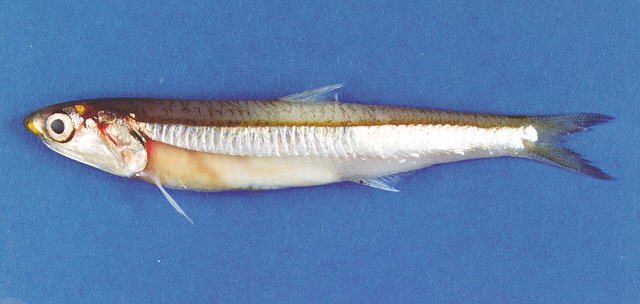| Engraulidae (Anchovies), subfamily: Engraulinae |
| 8 cm SL (male/unsexed) |
|
reef-associated; depth range 1 - 13 m |
| Indo-Pacific: widespread in the northern part of the Indian Ocean (Gulf of Aden, but apparently not the Red Sea nor Kenya, the Persian Gulf, India, Andaman Islands) and Western Central Pacific (Indonesia, Thailand, north to at least Taiwan Island, south to northern Australia; also eastward to Fiji and Tonga). |
|
Dorsal spines (total): 0-0; Anal spines: 0-0; Anal soft rays: 15-17. Belly rounded with 5 or 6 (rarely 3 or 4) sharp needle-like pre-pelvic scutes. Maxilla tip pointed, projecting beyond second supra-maxilla and reaching to sub-operculum. Isthmus short, preceded by a small bony plate on urohyal between branchial membrane. Unbranched dorsal and anal fin rays. In life, a bright silver band on flank, with a thin blue line above; back blue or grey. |
| Schooling species. Coastal pelagic (Ref. 68964). Occurs in estuarine and inshore waters. Probably feeds mainly on planktonic crustaceans. Breeds throughout the year, with peaks in New Ireland waters during May to June or July and possibly also in September to November. Eggs are oval, without a knob at one end. |
|
Not Evaluated
(Ref. 96402)
|
| harmless |
|
Source and more info: www.fishbase.org. For personal, classroom, and other internal use only. Not for publication.
Page created by Jen, 05.08.02,
php script by kbanasihan 06/09/2010 ,
last modified by
dsantos, 20/08/10

